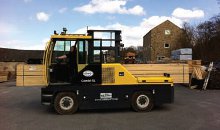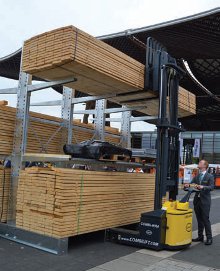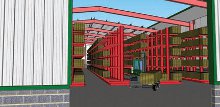Lifting innovation
10 August 2013Combilift’s focus on R&D means in its 15-year history it has continually developed new models. Liz Townsend reports.
Since Combilift was established in 1998 it has notched up an enviable record of growth and has supplied over 19,000 units of its range of 4-way forklifts to customers in more than 75 countries. The two founders - managing director Martin McVicar and technical director Robert Moffett - are still at the helm of the company and remain as enthusiastic about developing innovative materials handling solutions as they were in their pioneering days.
The concept of a truck that can change the direction of its wheels at the touch of a button changed the face of materials handling at an unmatched pace. The Combilift - the world's first engine-powered, all-wheel drive multidirectional forklift, enabled operations to ditch previous combinations of other types of trucks in favour of this universal machine, a very attractive proposition in terms of efficiency and flexibility in and around the warehouse and loading yards.
The timber sector was one of the first to recognise the benefits of Combilift's customised approach and still accounts for a large percentage of sales. Starting with an output of just 18 trucks in its first year, the company is now celebrating 15 years in business and has won numerous awards for its products that are acknowledged as market leaders for safe and productive handling of long and awkward loads.
Martin McVicar attributes the continued growth of the company to several factors. "Substantial investment in R&D - 9% of yearly turnover - has enabled us to continually bring new models to the market, which incidentally meant that we were much less affected during the downturn than most mainstream fork lift manufacturers," he said.
"Customer feedback has also been pivotal for new product development. As there is no one typical set of requirements for individual applications, our production line was configured at the outset to offer a very high degree of customisation. We use standard and readily available components so that our products can be easily maintained and serviced wherever in the world they are being used."
The 15th year has seen the launch of more products and a step in a new direction with the introduction of Combilift's smallest models and first pedestrian reach stackers - the Combi-WR (Walkie Reach) range. Once again they were inspired by practical requirements.
"We were getting the message from customers in the DIY and timber sector that they wanted a smaller capacity unit to handle lighter loads, and the result is the Combi-WR and the 4-way Combi-WR4. These handle palletised material as well as longer loads such as packs of timber or laminate in confined areas and offer safe operations in areas where the public and employees may be present," said Mr McVicar.
With lift heights of 4.2m and a load capacity of 1,450kg, electronic power steering, pantograph and side shift functions, the Combi-WR is the only pedestrian reach stacker which can work in an aisle width of 2m pallet to pallet. The multi-position tiller incorporates push-button rotation of the rear wheel parallel to the chassis for placing and picking in the aisle and the operator's position at the side of the machine, rather than between the racking and the truck, offers enhanced safety.
A further development of relevance to the timber sector is Combilift's new four-wheeled, two-directional sideloader, which is ideal for operations that require reliable, robust and fast operation when moving timber across extensive sites. Overheating during prolonged operation is a common problem with many sideloaders but Combilift has counteracted any risk of this by incorporating a single Bosch Rexroth variable piston hydrostatic drive motor coupled with a rugged and proven JCB differential axle, as used on the JCB 3CX backhoe model.
The new design features a fully-glazed front cab panel and the engine is situated in a low level compartment underneath the platform, both of which contribute to excellent visibility. One of the first UK companies to take delivery of this model is Skipton timber and builders merchant Merritt and Fryers Ltd, which is using the truck for handling larger packs of timber.
Combilift's website has also undergone a redesign and, as well as comprehensive information on its product range, there is a much larger section devoted to the company's warehouse design service.
"We employ a team of six highly qualified design engineers who work full time on this, which gives you an idea of the demand for this service around the world," said Mr McVicar. "From initial information provided, they create diagrams of layouts using our design software and 3D simulations which can illustrate possible space savings of up to 100%. We are one of just a few companies offering a fully free of charge service; others will offer basic advice and then expect a consultant to step in to proved more details - which naturally comes at a price."
Mr McVicar remains committed to doubling last year's record turnover within the next five years by increasing the product portfolio and further expanding production facilities in Co Monaghan. With six sons between them it also looks like Mr Moffett and Mr McVicar will keep the business a family affair for the foreseeable future.



